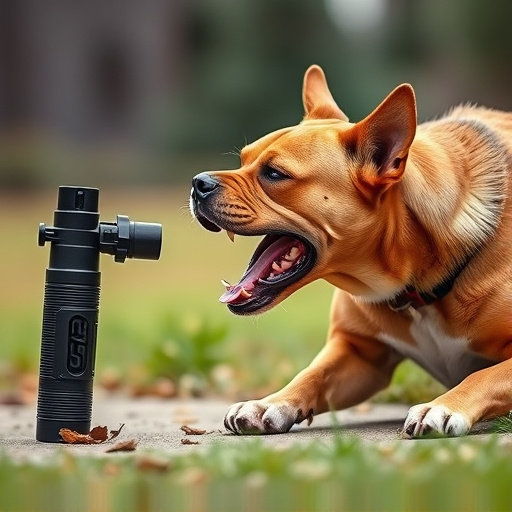Canine repellents offer a safe, non-lethal method for managing problematic animals, prioritizing human and pet safety through specific active ingredients and stringent legal regulations. Key safety features include non-toxic ingredients, wide reach application, compliance with local laws, secure storage, and proper use instructions. Effective deployment involves understanding product profiles, good ventilation, protective gear, addressing root causes of animal intrusion, regular maintenance, and monitoring for optimal coexistence between humans and wildlife while adhering to Safety Features in Canine Repellents.
Animal control sprays, particularly those designed as canine repellents, offer a strategic approach to managing unwanted animal interactions. This comprehensive guide delves into the intricate world of these repellents, exploring their legal dimensions and safety features crucial for responsible use. Understanding the regulatory landscape ensures compliance while effective application strategies maximize results. Discover key considerations, from safety mechanisms in canine repellent sprays to best practices for responsible management, empowering you with the knowledge to navigate this evolving domain.
- Understanding Animal Control Sprays: A Comprehensive Overview
- Legal Frameworks and Regulations Governing Canine Repellent Use
- Key Safety Features to Consider in Dog Repellent Spray
- Responsible Application and Effective Management Strategies
Understanding Animal Control Sprays: A Comprehensive Overview
Animal control sprays, also known as canine repellents, are specialized products designed to deter and manage problematic wildlife or domestic animals. These sprays offer a non-lethal approach to animal control, focusing on safety and effectiveness. Understanding their legal use and the safety features they incorporate is essential for responsible application.
Safety features in these repellents encompass various components. One key aspect is their selective action, ensuring minimal harm to non-target species and the environment. Many animal control sprays are formulated with specific active ingredients that target certain behaviors or senses of animals without causing long-term damage. Additionally, they often include user safety measures, such as simple application methods, quick-acting formulas, and instructions for safe storage, ensuring that both applicators and nearby individuals remain protected.
Legal Frameworks and Regulations Governing Canine Repellent Use
The legal frameworks governing the use of canine repellent sprays vary significantly across regions, reflecting a balance between public safety and animal welfare concerns. In many countries, these products are classified as pesticides, subject to stringent regulations aimed at minimizing environmental impact and ensuring user safety. Regulations often dictate the active ingredients that can be used, concentration limits, application methods, and prohibited areas for use. For instance, some regions prohibit the use of repellents containing toxic chemicals near water bodies or in urban settings to protect both wildlife and human health.
Safety features in canine repellent sprays are paramount. Manufacturers must adhere to guidelines ensuring the products are safe for both animals and humans upon exposure. This includes considerations like irritant levels, odour profiles that do not cause distress to pets or people, and instructions for responsible application. Repellents should be designed with a focus on non-lethal deterrents, encouraging safe coexistence between humans and wildlife rather than causing harm. Compliance with these regulations is crucial for legal use, promoting the responsible management of canine repellents as a viable solution in areas where wild animals pose potential threats to human activities.
Key Safety Features to Consider in Dog Repellent Spray
When choosing a dog repellent spray, understanding its safety features is paramount to ensure both your well-being and that of your canine companions. Key safety considerations include checking for non-toxic ingredients, as many effective repellents use natural components like capsaicin (from chili peppers) or citronella oil, which are generally safe for pets and humans when used correctly. Additionally, look for sprays with a wide reach to minimize direct contact, and those that offer a gentle, misting application to avoid irritations.
Other important safety features involve checking the spray’s classification as pet-safe and ensuring it complies with relevant regulations. Repellents designed specifically for dogs will have undergone testing to verify their effectiveness without causing harm. Additionally, always store such sprays out of children’s reach and secure from pets, and read the instructions carefully before use to prevent any potential adverse reactions or misuse.
Responsible Application and Effective Management Strategies
When using animal control spray, particularly those with canine repellent properties, it’s paramount to adhere to responsible application practices for both safety and effectiveness. This involves understanding the product’s safety features, such as non-toxicity to humans and pets when used as directed, and ensuring proper ventilation during application. Users should also wear protective gear like gloves and masks to avoid direct contact or inhalation of the spray.
Effective management strategies complement responsible application. These include identifying and addressing the root cause of the animal intrusion, such as securing trash cans, trimming foliage that provides hiding spots, and using scent barriers. Regular maintenance and monitoring are crucial to sustain these measures’ efficacy, ensuring a safer and more manageable environment for both residents and wildlife.
Animal control sprays, particularly canine repellents, offer a legal and effective solution for managing unwanted animal interactions. By understanding the legal frameworks and prioritizing safety features, users can responsibly employ these tools to protect both animals and people. Following best practices for application and management ensures their effectiveness while minimizing potential risks. Remember, proper use of animal control sprays is key to maintaining a harmonious coexistence between humans and wildlife.
